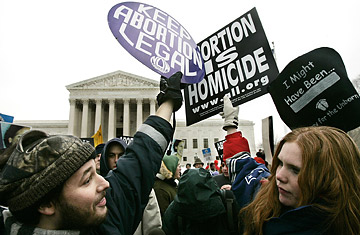
Pro-life and pro-choice groups face off in front of the U.S. Supreme Court in Washington, DC.
Thirty-five years after the Supreme Court legalized abortion in the U.S., abortion rates are at their lowest level in three decades — which gives both sides in the culture wars something to celebrate and plenty to fight over, while the rest of us try to figure out what happened.
According to the Guttmacher Institute's 2005 survey of abortion providers, the abortion rate fell 9% in five years, to 19.4 abortions for every 1,000 women between the ages of 15 and 44; the 1.2 million abortions performed in 2005 numbered 25% fewer than the high of 1.6 million in 1990. That would seem to be good news, whether you view abortion as an evil, or a necessary evil, or a routine medical procedure no more morally troubling than a tooth extraction.
The problem is that no one can prove what complex chemistry of cause and effect, culture and calculation, explains the falling rates — and for people who have devoted their lives to this issue, there's no glory in achieving one's ends if the means are anathema. Pro-choice groups credit comprehensive sex education and access to contraception, strategies that social conservatives often resist. Pro-lifers credit campaigns to tighten laws controlling access to abortion and to warn women about abortion's risks — which the other side deplores.
Meanwhile the vast majority of Americans watch from the sidelines and long for cease-fire, because the good news about falling abortion rates only illuminates the bad news underneath: Close to half of all pregnancies in the U.S. are unintended, and 40% of those end in abortion. The U.S. still has one of the highest teen-pregnancy rates in the developed world — nearly twice as high as England and Canada, eight times as high as the Netherlands and Japan — and in December, the Centers for Disease Control reported that the teen birth rate rose for the first time in 15 years. Likewise, the U.S. abortion rates are disproportionately high: Rates in Belgium, Germany and the Netherlands are less than half that in the U.S. — fewer than 10 abortions per 1,000 women aged 15 to 44.
With the two sides pulling in opposite directions, it's hard to see how progress comes. Groups like Planned Parenthood have fought hard to expand access to contraception, such as Plan B, the "morning after pill," which was finally approved for over-the-counter use in 2006. And they have fought for comprehensive sex education, which includes information about contraception as well as abstinence. A Guttmacher study in 2006 found that roughly "14% of the decline in teen pregnancy between 1995 and 2002 was due to teens' delaying sex or having sex less often, while 86% was due to an increase in sexually experienced teens' contraceptive use." Fewer unwanted pregnancies, pro-choice groups argue, is the key to fewer abortions: In fact, the abortion rate among teenagers has been falling most sharply.
But pro-life activists can point to another set of statistics that suggests it is their crusade that has made the difference. Certainly, laws restricting access have had an impact, especially in a state like Mississippi, which now has only a single abortion provider. But attitudes matter as well. Sex education and contraception might account for fewer unintended pregnancies, but more women who become pregnant are deciding to carry the child to term. Guttmacher found that 22.4% of pregnancies (not including those that ended in miscarriage) ended in abortion, down from 30.4% in 1983. That would seem to be evidence that the quiet campaign for women's hearts and minds, conducted in thousands of crisis pregnancy centers around the country, on billboards, phone banks and websites, is having an effect, while the combination of tighter access, waiting periods and parental notification laws invite — or force — women to think twice about terminating a pregnancy.
And, indeed, the Associated Press recently reported signs of a baby boomlet: The U.S. now has a higher fertility rate than most industrialized countries, and the 4.3 million births recorded in 2006 was the most since 1961. Some of this is due to a larger overall population and the high fertility rates among Hispanics — the fastest-growing minority group in the U.S. — but other groups showed increases as well. This leaves experts explaining why Americans are just generally more optimistic and child-friendly than many other countries. "Americans like children," Nan Marie Astone, associate professor of population, family and reproductive health at Johns Hopkins University, told the AP. "We are the only people who respond to prosperity by saying, 'Let's have another kid.'"
America was already caught in a culture war when Roe was first decided: over Vietnam, over sex, drugs and rock 'n' roll, over the place of women and the limits of government. In one sense, the story of the last 35 years is the tale of a subtle but sturdy consensus rising out of all the smoke and fire. The year after Roe, two-thirds of Americans favored abortion on demand. Now, after years of private and public debate, most people freely tell pollsters they'd prefer fewer abortions, but a majority embraces the inherent contradiction of "safe, legal and rare." "Safe" and "legal" speak to the sad fact of bad options: women who have been raped, whose pregnancy threatens their health, whose fetuses are fatally deformed. "Rare" speaks to a more widely acknowledged recognition that for many people the decision to end a pregnancy comes at a cost.
It's not a comfortable position: The purists on both sides have much stronger arguments about morality and autonomy and consistency. But in the cloudy middle is where life is lived and laws are made and remade: Maybe the thing to celebrate 35 years after one of the most fateful judgments in the High Court's history is our willingness to continue to wrestle with the reasons long after the judges have ruled.
